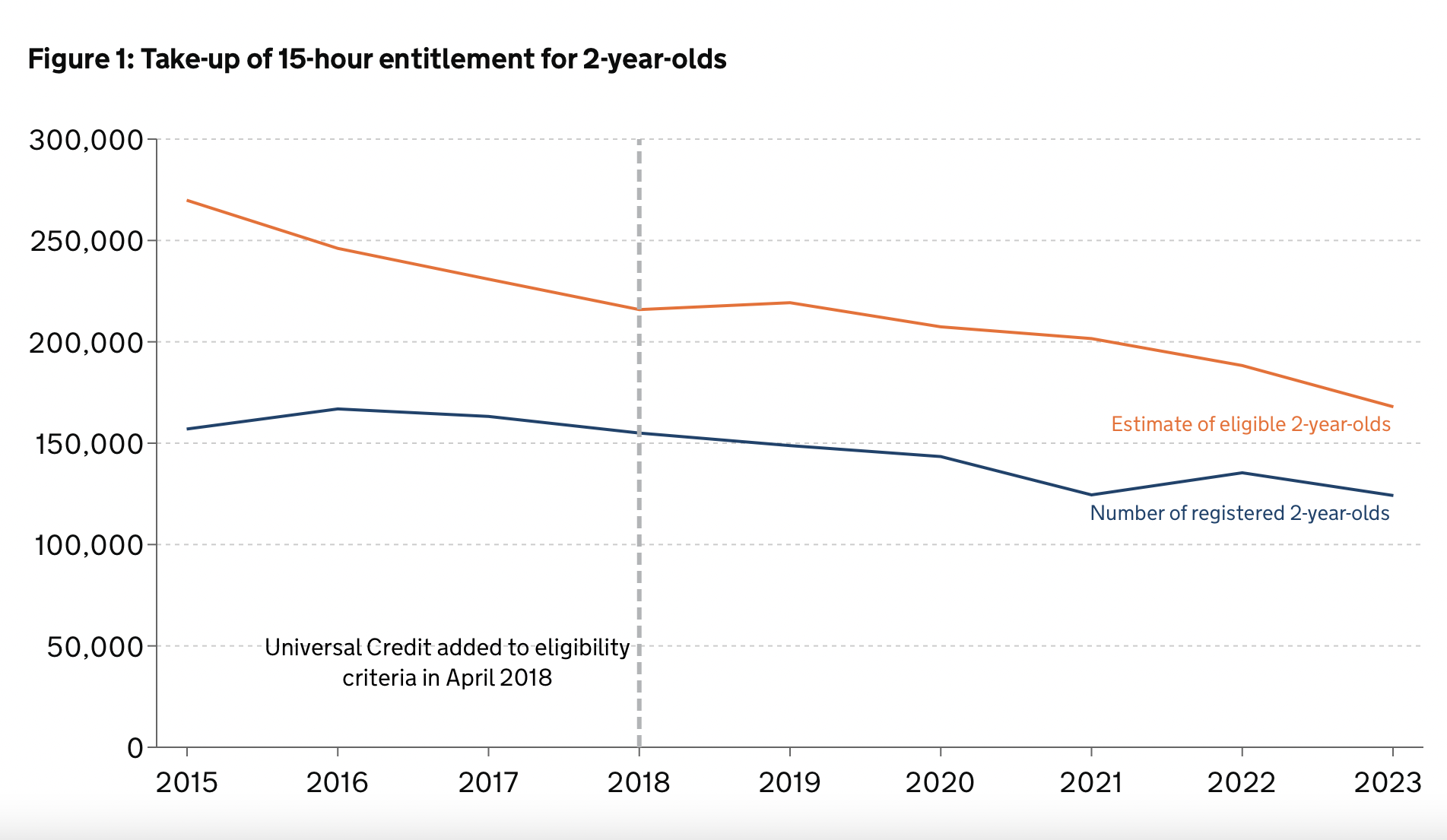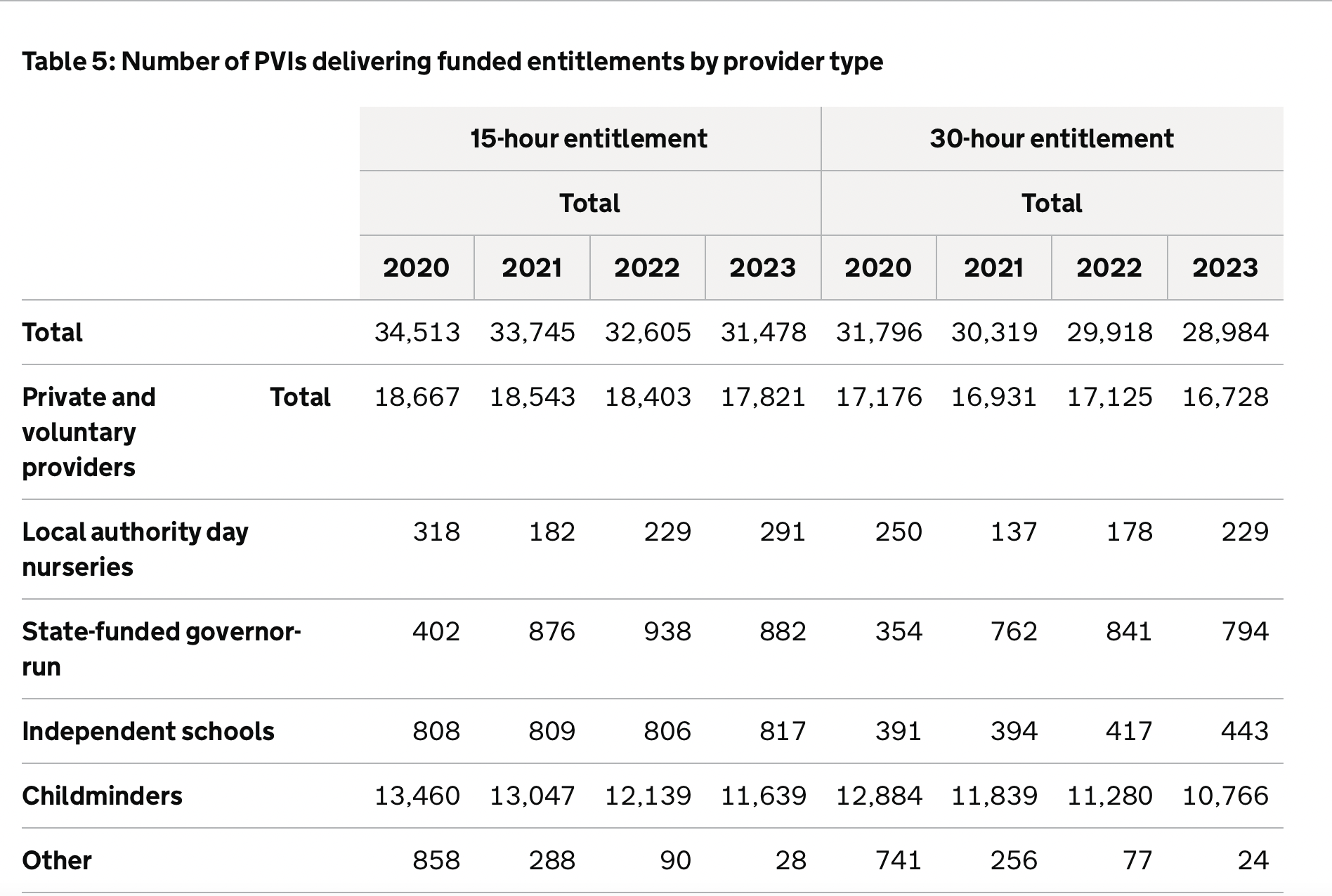
The Department for Education attributed some of the drop in two-year-olds registered for 15-hour childcare to a ‘sizeable fall’ in the birth rate between 2015 and 2020, but said that 'declines in birth rates only partially explain' the decrease in the number of two-year-olds eligible and registered for the 15-hour entitlement.
In a note on the statistics it also attributed it to changes in the benefits system. The fall in parents of two-year-olds receiving legacy benefits (a decrease of 190,000 between 2018 and 2023) hasn't been offset by the rise in those receiving Universal Credit, it said.
In addition, the maximum income thresholds for the eligibility criteria have remained unchanged in recent years while average incomes have increased.
The figures come from the Education provision: children under 5 years of age statistics published by the Department for Education, on government-funded early education and childcare for two-to four-year-olds in England on 18 January 2023.
KEY STATS
15 HOURS
Two-year-olds – 124,200 registered, down 8 per cent since 2022 and lowest recorded
Estimated take-up 74 per cent (up from 72 per cent in 2022)
Three- and four-year-olds – 1,224,500 million registered, down 1 per cent since 2022, lowest recorded
Number of PVI Providers delivering 15 hours is 31,500, down by 3 per cent from 2022
30 HOURS
Three- and four-year-olds – 363,000, up 4 per cent since 2022 and highest since records started in 2018
Estimated to be around four in five eligible children
QUALIFICATIONS
Fall of 4,400 staff in PVI providers with a Level 3 qualification (see below)
15-hour entitlement
The Department for Education said that despite the falls in children registered for the 15-hour entitlements, the associated take-up rates in 2023 have increased because of larger decreases in the relevant populations (particularly for eligible two-year-olds).
The number of two-year-olds and three- and four-year-olds registered for the 15 hours fell to the lowest recorded, down 8 per cent (-11,200) and 1 per cent (-16,200) since 2022 respectively.
However, despite the fall in populations, the estimated take-up rate for eligible two-year-olds was at its highest recorded, and for three and four-year-olds the highest since 2018.
Commenting, Jonathan Broadbery, director of policy of National Day Nurseries Association (NDNA), said, ‘It’s heartening to see that take-up of funded places is up again after the pandemic because we know that access to early education and care can make a real difference to children’s outcomes all through their education.
'However, the take-up among children from disadvantaged backgrounds for two-year-old places is still lower than other groups. This is a concern because these are the children who have the most to gain from early education.’

Source: DfE, Education provision: children under 5 years of age statistics (6 July 2023)
Private, voluntary and independent providers (PVIs) delivering 15 and 30 hours
The number of PVI providers delivering the 15-hour and 30-hour entitlements has decreased every year between 2020 and 2023, with a total overall fall of 3,000 providers (-9 per cent) and 2,800 providers (-9 per cent) respectively. These falls have mainly been driven by decreases in childminders and private and voluntary providers.
The latest figures for both the 15-hour and 30-hour entitlement are the lowest in the series across all PVI providers and childminders.
However, PVI providers continue to deliver the majority of Government-funded places – 80 per cent of eligible two-year-old places and 70 per cent of 30-hour places.
The NDNA said that 'without their input' the Government's policy would 'fail'.
'The Government must support them to be sustainable and be able to deliver additional places from April 2024 once all two-year-olds of working parents can apply for a 15-hour place,' Broadbery added.

Source: DfE, Education provision: children under 5 years of age statistics (6 July 2023)
Special Educational Needs
The percentage of children registered for the 15-hour and 30-hour entitlements who have SEN has increased across all age groups, with the latest figures being the highest recorded.
Percentage of children registered for 15 and 30 hours with SEN
15 hours – 4.9 per cent of two-year-olds/8 per cent of three-and four-year-olds (up from 4.1 per cent and 7 per cent respectively in 2022)
30 hours – 4.1 per cent (up from 3.3 per cent in 2022)
Ethnicity
Where known, 17 per cent of three-and four-year-olds registered for the 30 hours were from an ethnic minority background, compared to 28 per cent of three- and four-year-olds registered for the 15 hours.
This compares to 30 per cent of twos registered for the 15 hours who were from an ethnic minority background.
Staff Qualifications
Staff qualifications data relates to private, voluntary, and independent (PVI) providers only.
In 2023, there were 250,600 staff delivering funded entitlements in PVI providers, up 1,400 staff (0.6 per cent) on a year earlier but down 5,700 staff (-2.2 per cent) since 2020. However, the latest annual rise masks a large fall of 4,400 staff with a Level 3 qualification, which has been offset by a large rise of 6,000 staff without an EY qualification.
The proportion of staff without an early years’ qualification has increased each year from 17 per cent in 2020 to 21 per cent in 2023.









